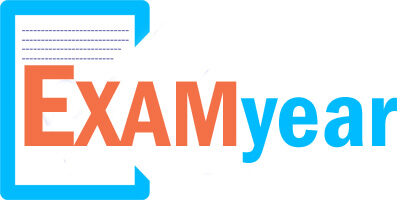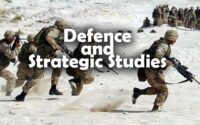Defence and Strategic Studies MCQs
1. Defence policy of a country aims at :
(A) Maintaining International Peace
(B) Safeguarding Territorial Integrity
(C) Protecting National Image
(D) Preserving Sovereignty
2. Who rules ……………….. commands the heartlands. Who rules the heartland, commands the World Islands. Who rules World Island commands the World ?
(A) Western Russia
(B) Western Europe
(C) East Europe
(D) Central Europe
3. In 1943 Mackinder reassessed his theory of land power and came with the concept of ‘Midland Basin’. Which of the following regions is not part of Midland Basin ?
(A) North Atlantic Ocean
(B) Western Europe
(C) Western United States of America
(D) Eastern United States of America
4. According to Alfred T. Mahan what is/are the element of Sea power ?
(A) Physical configuration
(B) Geographical position
(C) Extent of territory
(D) All of the above
5. Who was a key proponent of ‘strategic bombing in aerial warfare’ ?
(A) Giulio Douhet
(B) L. B. H. Liddell Hart
(C) Mao Zedong
(D) None of the above
6. The book on Thermo-Nuclear War was written by :
(A) Herman Kahn
(B) Robert Kaplan
(C) Henry Kissinger
(D) Lawrence Freedman
7. The system theory is associated with :
(A) Mortan Kaplan
(B) Hans J. Morgenthau
(C) Richard Snyder
(D) Burtin Sapin
8. Who was the first scholar use the word ‘Superpower’ as it is currently used ?
(A) George Perkovich
(B) Nicholas Spyman
(C) Kenneth Waltz
(D) John Mearshimer
9. Which one of the following is the origin of strategic studies ?
(A) Thucydides writings on the Peloponnesian war
(B) Edward Meade Earle’s Seminar on grand strategy and conduct of war
(C) E. H. Carr’s ‘Twenty Years Crisis’ that presents a critique of Liberalism
(D) Hans Morgenthau’s work on ‘Politics Among Nations : The Struggle for Power and Peace’
10. Name the American diplomat who wrote the ‘long telegram’ which formed the basis of American policy of ‘containment’ towards the Soviet Union during the Cold War :
(A) Medeleine Albright
(B) George Keenan
(C) Ralph Bunch
(D) Dean Rush
11. Who is the author of Man, the State, and War ?
(A) Stephen Krasner
(B) Kenneth Waltz
(C) Robert Keohane
(D) John Mearshimer
12. Who wrote the book ‘‘India at Risk’’ ?
(A) Sardar Vallabhbhai Patel
(B) Jaswant Singh
(C) C. Rajagopalachari
(D) Atal Behari Vajpayee
13. Who is an important Air-Warfare theorist among the following ?
(A) B. H. Liddle Hart
(B) Alfred Thayer Mahan
(C) Billy Mitchell
(D) Carl Von Clausewitz
14. Which famous person made the following statement : ‘‘The seed of war in the world is industrial and commercial rivalry’’.
(A) Mahatma Gandhi
(B) Martin Luther King
(C) Nelson Mandela
(D) Woodrow Wilson
15. Which gas was released during Bhopal gas tragedy ?
(A) Nitrogen cyanide
(B) Methyl isocyanate
(C) Methyl nitrate
(D) Methyl cyanide
16. Assertion (A) : Terrorism makes a country’s politics difficult and complicated to handle.
Reason (R) : International terrorism is a dangerous and harmful to the human life.
Codes :
(A) Both (A) and (R) is correct
(B) Both (A) and (R) are incorrect
(C) (A) is correct but (R) is not correct
(D) Both (A) and (R) are correct and (R) is the correct explanation of (A)
17. Who among the following argued that ‘‘Terrorism is not like a disaster before which we are helpless ?
(A) Baraq Obama
(B) George P. Shultz
(C) Bill Clinton
(D) George W. Bush
18. The treaty of Rarotonga is a ……… .
(A) Nuclear Arms Reduction Treaty
(B) Nuclear Weapons Free Zone Treaty
(C) Chemical Weapons Free Zone Treaty
(D) None of the above
19. What is the name of the organisation which is the implementing body for the Chemical Weapons Convention (CWC) ?
(A) International Chemical Weapons Agency
(B) Organisation for Implementing Chemical Weapons
(C) International Organisation for Verification of Chemical Weapons
(D) Organisation for the Prohibition of Chemical Weapons
20. The ‘‘Atoms for Peace’’ speech was made by which American President in the United Nations General Assembly ?
(A) Woodrow Wilson
(B) Franklin D. Roosevelt
(C) John F. Kennedy
(D) Dwight Eisenhower
| GK | Previous Papers |
| Practice Question | Quiz |
| Mock Test | Objective Papers |
| Old Question | MCQs |
| Sample Papers | UGC NET Solved Papers |
| Model Question |
21. Which one of the following International Organisation was established to verify the obligations of the members of the Nuclear Non-Proliferation Treaty (NPT) ?
(A) Organisation for the Prohibition of Chemical Weapons
(B) Implementation Support Unit
(C) International Atomic Energy Agency
(D) International Monitoring Stations
22. Arrange historical stage of warfare in its chronological order :
(1) Nuclear Warfare
(2) Trench Warfare
(3) Tank Warfare
(4) Cyber Warfare
Codes :
(A) (1), (2), (3), (4)
(B) (4), (3), (2), (1)
(C) (2), (3), (1), (4)
(D) (1), (4), (3), (2)
23. Which one of the following is not related to trade ?
(A) SAPTA
(B) TRIPS
(C) WTO
(D) NPT
24. Mutually Assured Destruction means …………………….. .
(A) Retaliation and destruction of enemy after attack with conventional weapons
(B) Retaliation and destruction of enemy after attack with chemical weapons
(C) Retaliation and destruction of enemy after attack with nuclear weapons
(D) None of the above
25. Restricting research, manufacture and deployment of deadly weapons of mass destruction is called ……… .
(A) Arms Race
(B) Sanctions
(C) Disarmament
(D) Arms control
26. Which one of these International Organisations issues common control lists (CCL) of items with potential dual-use applications that require export licenses ?
(A) Australia group
(B) Nuclear suppliers group
(C) World Health Organisation
(D) Wassenaar Agreement
27. The use of ‘Anthrax’ began in which War ?
(A) Gulf War
(B) First World War
(C) Second World War
(D) Korean War
28. Choose the correct author of the statement below :
‘‘Strategy is …….. the art of the dialectic of force or, more precisely, the art of the dialectic of two opposing wills using force to resolve their dispute’’.
(A) Andre Beaufre
(B) Robert Osgood
(C) Liddell Hart
(D) Carl Von Clausewitz
29. Which one of the following North-East States of India is surrounded by Bangladesh from three sides ?
(A) Assam
(B) Tripura
(C) Meghalaya
(D) Arunachal Pradesh
30. ‘‘One for all, all for one’’ is a concept related to :
(A) Military Alliance
(B) Collective Security
(C) Deterrence
(D) Detente
31. The fundamental rights have been given in the Indian Constitutions :
(A) From Articles 12 to 35
(B) From Articles 13 to 36
(C) From Articles 15 to 39
(D) From Articles 36 to 51
32. Who introduced culture into modern security studies by developing a theory of strategic culture to interpret Soviet Nuclear doctrine ?
(A) Jack Snyder
(B) Thucydides
(C) Machiavelli
(D) Kenneth Waltz
33. Who among the following propounded ‘National Character’ as one of the elements of Sea Power ?
(A) Carl Von Clausewitz
(B) W. Mitchell
(C) Jomini
(D) Alfred T. Mahan
34. Which International treaty gave rise to the idea of Sovereign nationstates?
(A) Treaty of Westphalia
(B) Treaty of Versailles
(C) Concert of Europe
(D) Treaty of Rome
35. ‘‘States are motivated by morality and values.’’ This statement is related to :
(A) Liberalism
(B) Constructivism
(C) Realism
(D) Idealism
36. ‘Security dilemma’ refers to which one of the following ?
(A) A structural nation in which states attempt to look after their security regardless of other states intentions which leads to rise in insecurity
(B) Offensive posture of any nationstate
(C) It is a dilemma a state faces when constructing national security plans
(D) Where states help in spreading instability and conflict between other states
37. The origin of the state is not based on :
(A) Theory of Divine Origin
(B) Social Contract Theory
(C) The Theory of Economics
(D) The Theory of Force
38. Which of the following statements explains the concept of collective security ?
(A) Principle of one for all and all for one
(B) Principle of all against all
(C) Principle of few against all
(D) Principle of no one against all
39. Who founded the Zeitschriff fur Geopolitik (Journal for Geopolitics) ?
(A) Karl Haushofer
(B) Zbigniew Brzezinski
(C) Friedrick Ratzel
(D) A. T. Mahan
40. The Strait which connects Mediterranean Sea to the Atlantic Ocean is :
(A) Gibraltar Strait
(B) Bering Strait
(C) Bosphorous Strait
(D) Bab-el-Mandab
41. Which political thinker wrote ‘The Republic’ ?
(A) John Locke
(B) Aristotle
(C) Thomas Hobbes
(D) Plato
42. Samuel Huntington’s Clash of Civilizations’’ argued that the principal patterns of conflict and cooperation in the world were shaped by :
(A) Nation States
(B) Political Leadership
(C) Nationalism
(D) Culture
43. As per Colin Flint each country in the world defines its geopolitical code, consisting of five main calculations. Which of the following is not part of that ?
(A) Who are our current and potential allies
(B) Who are our current and potential enemies
(C) How can we maintain our allies and nurture potential allies
(D) How can we be friends with our current enemies and emerging threats
44. The book ‘Logic of Scientific Discovery’ is written by :
(A) David Hume
(B) Kenneth Waltz
(C) Karl Popper
(D) Karl Marx
45. Who is an important Air Warfare Theorist among the following ?
(A) B. H. Liddell Hart
(B) Alfred Thayer Mahan
(C) Billy Mitchell
(D) Carl Von Clausewitz
46. Which famous person made the following statement. ‘‘The seed of war in the Modern World is industrial and commercial rivalry :
(A) Mahatma Gandhi
(B) Martin Luther King
(C) Nelson Mandela
(D) Woodrow Wilson
47. What is the purpose of neutron scanning ?
(A) To detect cancer cells in the body
(B) To detect contraband items in containers
(C) To detect submarines
(D) For scanning documents
48. The wars in Iraq (2003) culminated in regime change of :
(A) Sunni regime
(B) Shia regime
(C) Bàathist regime
(D) None of the above
49. UNSC Counter-Terrorism Committee is assisted by CTED. What does CTED stand for ?
(A) Counter-Terrorism Executive Directorate
(B) Counter-Terrorism Committee Executive Directorate
(C) Council of Counter-Terrorism Executive Directorate
(D) Counter-Terrorism and Executive Directorate
50. Which one of the following is not an international organisation as per the definition given by Inis Claude ?
(A) United Nations
(B) G-8
(C) SAARC
(D) NATO

